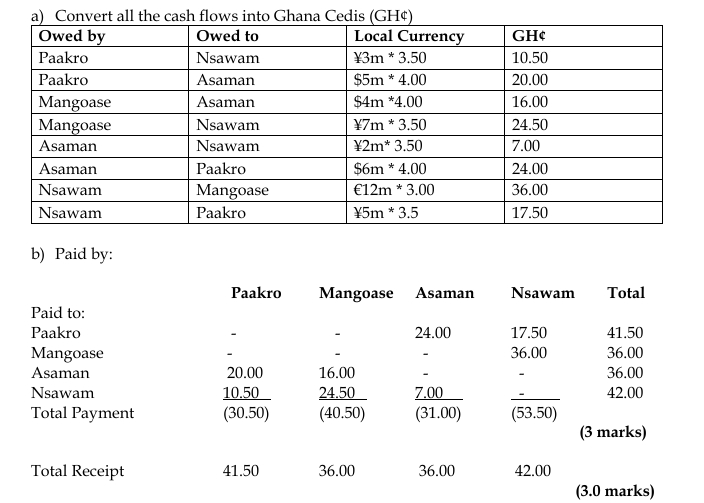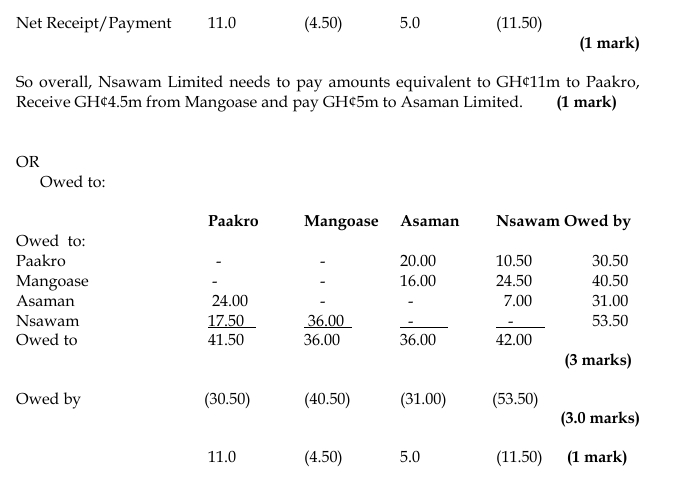- 10 Marks
Question
One of the key considerations for multinational companies is to decide on the price at which goods and services are transferred from one member of a group to another.
Kofas Ltd has been operating in four countries: Ghana, Nigeria, UK, and USA. The parent company and the subsidiaries have decided to use a transfer pricing policy.
Required:
You have been approached as a consultant to advise on the internal and external factors that will facilitate the transfer of goods and services from one member of the group to another. (10 marks)
Answer
Internal Factors Influencing Transfer Pricing:
- Goal Congruence:
Transfer pricing should align with the overall corporate goals, ensuring that divisional managers make decisions that optimize group-wide profits. The pricing policy should encourage transfers when they maximize overall company profits, while managers should avoid internal transfers when they are not beneficial for the group. - Performance Evaluation:
Transfer prices affect the reported profitability of each division within a multinational company. These prices should be set to ensure fair evaluation of divisional performance, without distorting results due to arbitrary pricing decisions. Properly set transfer prices ensure managers are held accountable for controllable outcomes. - Taxation:
The pricing policy can be structured to minimize tax liabilities across various jurisdictions. By setting transfer prices that allocate more profit to subsidiaries in countries with lower tax rates, companies can reduce their global tax burden, while complying with international tax laws. - Cash Flow Management:
The timing of cash transfers between entities, in terms of when goods and services are exchanged, can be optimized through effective transfer pricing to improve liquidity and manage cash across subsidiaries. This ensures the efficient use of working capital throughout the multinational group. - Profit Maximization and Cost Control:
Setting transfer prices that reflect the cost structure of the producing division and the purchasing power of the receiving division is crucial. Transfer prices should encourage efficient resource allocation and prevent waste by ensuring goods and services are valued appropriately within the company.
External Factors Influencing Transfer Pricing:
- Taxation and Regulations:
Different countries impose varying tax rates and regulations on transfer pricing. Multinational companies must navigate these differences to avoid penalties or double taxation. Transfer pricing strategies should comply with each country’s tax laws, such as those related to arm’s length pricing, while taking advantage of any tax benefits. - Currency Fluctuations:
Exchange rate fluctuations between countries like Ghana, Nigeria, the UK, and the USA can impact the profitability of inter-company transfers. Transfer prices may need to be adjusted to account for exchange rate risk, ensuring that the price set at the time of the transaction is still relevant at the time of settlement. - Government Restrictions:
Some countries impose restrictions on profit repatriation or limit the level of prices that can be charged between related parties. The transfer pricing policy should account for these restrictions, ensuring compliance with local regulations while maximizing the company’s ability to repatriate profits or minimize currency risk. - Inflation:
High inflation rates in one country (e.g., Nigeria) can erode the real value of cash flows. Transfer prices should be set to ensure that subsidiaries in high-inflation economies are not disproportionately impacted by rising costs, which could diminish their competitive position. - Market Conditions:
External market conditions, such as supply and demand in each country, should influence transfer pricing decisions. For example, if the UK market for a particular good is highly competitive, Kofas Ltd’s transfer pricing should reflect this, ensuring that the receiving subsidiary can remain competitive in that market.
Conclusion:
For Kofas Ltd, setting appropriate transfer prices requires careful consideration of both internal factors (such as goal congruence, performance evaluation, and cash flow management) and external factors (such as tax laws, currency risk, and government restrictions). The transfer pricing policy should be designed to ensure profitability, regulatory compliance, and operational efficiency across all four countries in which the company operates.
(Total: 10 marks)
- Topic: Treasury and Advanced Risk Management Techniques
- Series: MAY 2017
- Uploader: Dotse



